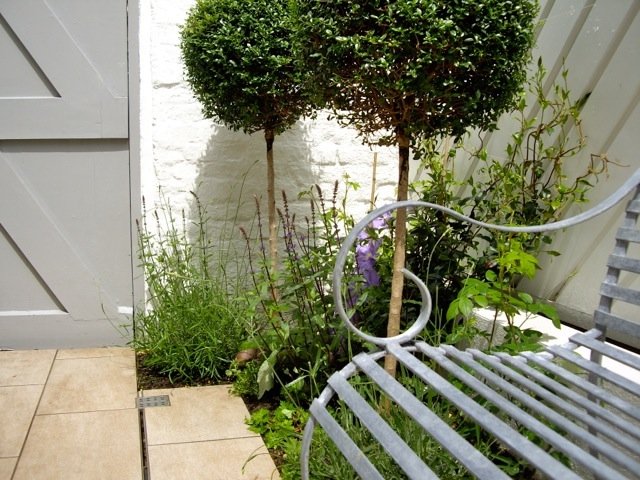Shady Gardens
If you have a small patch of garden in the middle of the city, the chances are that it is overlooked by a building, fence or perhaps your neighbours’ trees. Shaded gardens are one of the more common features in our compact city dwellings.
Although shaded gardens can provide many visual and practical challenges to the garden designer, they also offer an opportunity to create a wonderful, visually stimulating oasis of calm and tranquillity.
So what counts as shade?
There are different degrees of shade which will affect the types of plants which you are able to grow in your garden:-
Partial or semi-shade: This is usually determined by having three to six hours per day of direct sun in midsummer.
Deep or heavy shade: This is usually under dense tree cover and and can also be due to shading from buildings. If a garden bed or border benefits from less than two hours of direct sun per day, it is counted as being in heavy shade.
However a garden can still be a beautiful outdoor space, even if it is shady.
For some people a shaded garden can be seen as a problem….
Firstly because, as a rule, you can’t grow some of the brighter flowering plants such as roses, tulips or salvias in shady conditions and for many people a garden must have colour to be beautiful. However, whilst a lack of light can be a problem for plants which come from hotter or more tropical climates, there are many gorgeous plants which have adapted to the conditions found in shade.
Secondly, a shaded garden can suggest one which is cooler and perhaps not somewhere you would choose to sit. However it can provide a welcome retreat from our hotter summer weather. Whilst you can’t always do anything about a garden space being in the shade, you can design gardens to make the most of a shaded location and even embrace the qualities and opportunities of a shaded spot.
A shady garden does not have to be a bland and colourless area. With good planting and the use of hard landscaping you can have a gorgeous, lush sanctuary in even the shadiest of garden spaces. Shaded gardens and outdoor spaces offer the chance to successfully grow plants which thrive in woodland and cooler climates. Ferns, hellebores, hydrangea, heuchera and a whole host of other wonderful leafy and flowering plants will thrive in the cooler, shadier garden.
The challenges of and solutions to shaded garden design:
Shaded gardens often come hand in hand with being small. If this is the case, try not to clutter your garden or make it too distracting. A very successful way of handling small and shaded outdoor spaces is to play on a theme; for example ferns and hostas come in a multitude of sizes, colours and styles and can create a tapestry that captivates the eye.
Make planting areas moveable; pots and planters are a great way to grow plants that need some light throughout the year. If the sun falls on different areas of your garden over the year then you may want to plant tulips, roses or other sun light loving varieties in pots, so that they can be repositioned to catch the light.
Use light reflecting materials such as polished paving stone, glass, mirrors and chrome metals to bounce the light around the garden.
Include plants with shiny, light reflecting leaves, such as Fatsia japonica, to lighten the garden. Similarly, shade loving plants with white flowers, such as hellebores, aquilegia or anemone will lighten dark and shady areas.
Use lighting to brighten up the shade on darker days and into the evening.
If the space allows you may want to consider adding a fire pit or an outdoor cooking area which will add warmth and brightness on the cooler darker evenings.
Consider alternatives to lawn in shady areas. Lawn will often struggle in shade and become sparse and muddy. It may be better to replace it with planting borders or maybe even a patio seating area.
Shaded Garden Design Case Study
The shaded basement garden we designed for our clients in Hampstead proves you can have a glorious space even in a fairly shady basement area.
The challenges of this small, shaded courtyard:
The garden was shaded due to the small space and tall walls surrounding it.
The garden was on two different levels, the drop to the basement kitchen required a solution for a safe and attractive passage up and down between the levels.
The dark paving tiles made the space feel smaller plus they lacked grip and were dangerously slippery when wet.
The uninterrupted white walls made the garden feel a little stark rather than light.
The clients didn’t have much time for gardening so needed a fairly low maintenance garden.
Solutions to make this shaded garden a space to enjoy
We planted a minimalistic palette of shade loving species which gave maximum impact without making the space seem too ‘busy’ or cluttered.
The plants and materials were chosen to be low maintenance and easy to care for.
We introduced new paving which was much paler in colour and had a non-slip finish. The new paving allowed more light to bounce around the space and the non-slip finish made moving between the two levels safer.
Our shady Hampstead courtyard after our redesign.
Do you have a shaded garden that you want redesigned?
Contact Sarah at Hampstead Garden Design and we can talk through the challenges and solutions.


